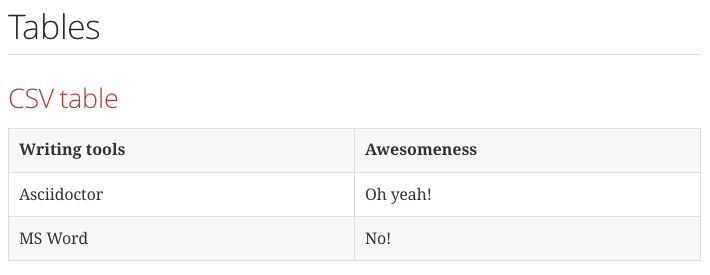Awesome Asciidoctor: CSV and DSV Tables
With Asciidoctor we can create tables where the header and rows are in CSV (Comma Separated Values) and DSV (Delimiter Separated Values) format. Normally we use a pipe-symbol (|) to separate cell values. This is actually PSV (Prefix Separated Values) :-).
In the following Asciidoctor markup we create a very simple table with a header and two rows using CSV:
= Tables
== CSV table
[format="csv", options="header"]
|===
Writing tools, Awesomeness
Asciidoctor, Oh yeah!
MS Word, No!
|===
We generate this into HTML and we get the following result:
Asciidoctor provides also another way to define the above table:
= Tables
== CSV table
// Define table using CSV syntax.
// The start and end of the table is defined
// as ,=== instead of |===.
// Also the header row is followed by new line,
// to indicate it is the header row.
,===
Writing tools, Awesomeness
Asciidoctor, Oh yeah!
MS Word, No!
,===
// We can also specify a separator.
[format="csv", separator=";", options="header"]
|===
Name;Description
Asciidoctor;Awesome way to write documentation
|===
The previous samples used a comma to separate values, but we can also use colon (:). The next sample contains tables defined with DSV:
== DSV table
[format="dsv", options="header"]
|===
Writing tools:Awesomeness
Asciidoctor:Oh yeah!
MS Word:No!
|===
// Alternative syntax:
:===
Writing tools: Awesomeness
Asciidoctor: Oh yeah!
MS Word: No!
:===
With the include directive we can also include data from an external CSV of DSV file to create a table (of course also the traditional pipe-symbol separated format can be in an external file):
= Table with external data
[format="csv", options="header"]
|===
include::tools.csv[]
|===
The file tools.csv has the following contents:
Writing tools, Awesomeness
Asciidoctor, Oh yeah!
MS Word, No!
Code written with Asciidoctor 1.5.0.

